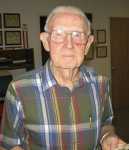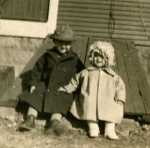Children of the Depression

By Colette Lefebvre
Herald-Tribune
"And then the dispossessed were drawn west -- from Kansas, Oklahoma, Texas, New Mexico; from Nevada and Arkansas, families, tribes dusted out, tractored out. Car loads, caravans, homeless and hungry, twenty thousand and fifty thousand and a hundred thousand and two hundred thousand. They streamed over the mountains, hungry and restless -- restless as ants, scurrying to find work to do -- to lift, to push, to pull, to pick, to cut -- anything, any burden to bear, for food. The kids are hungry. We got no place to live. Like ants scurrying for work, for food and most of all for land."

-- Excerpt from John Steinbeck's "The Grapes of Wrath," 1939.
It blew and blew and blew for days and days. Across the Midwest, Americans were covered in the red dust clouds. Topsoil that blew from Oklahoma and Texas continued on to Missouri. Missouri was hit by many hardships in the 1930s -- not just financially, either. In the Southwestern area, namely Vernon County, there were dust storms. People dipped their sheets in water and placed them in windows, to deter the ever-gnawing dust from coming in. For eight years the dust blew, in a yellowish, red-brown haze from the south lands and in rolling black walls from the North. Children wore dust masks in some parts of the country. Bourbon County and Vernon County women hung sheets over windows as farmers watched crops wither and fly away.
According to locals, many people had fallen upon "skinny times."

Hobos, or transients, as the papers in those days called them, skipped in and out of Nevada and Fort Scott, in search of quick money or a handout.
The dust bowl conditions lasted for a decade, primarily impacting the southern plains and northern plains, in fact the agricultural devastation was worldwide.
World War I, poor agricultural practices and years of a sustained drought caused the Great Depression and dust bowl.
Following World War I, a recession led to a drop in market prices for farm crops and caused many Midwestern farmers to overproduce through mechanization. The increased farming activity required increased spending and caused many farmers to financially overextend themselves as well.
During the years of adequate rainfall, the land produced bountiful crops, but as the droughts of the early1930s deepened, the farmers continued to hope, to plow and to furrow ground that was tired. Soon, the plague of the 20th century began, literally. Topsoil blew about in large waves, locusts destroyed crops in the upper plains, and large packs of coyotes descended upon Vernon County.
The local paper at the time, known as the Southwest Mail, was filled with desperate and depressing stories.

In one obituary, a Butler man became sick and died from malnutrition. At the time of his admittance to the hospital he weighed almost 65 pounds, at age 70.
Memory of Metz: Madge Baze
"I lived near where the McGennis Youth Center is now. I remember how hot and dry it was. Mostly, I remember it was the first year my brothers tried to farm and the corn didn't grow. We had no electricity, and on hot days we slept outside.
"To me it isn't as dry now as it was then. The corn didn't get as high as it does now. My folks sent us to school in Metz and I graduated in 1938 from Metz High School. My parents are Paul and Roxie Lyons. We had an old Ford without a top and sometimes we got a ride to school.
"Well, I remember dime stores, in Nevada, and my grandmother came once a month to town.
"We used to keep the milk and butter down in the well so that it would stay cool. Dad found a job, when he could, working at farms, with chicken for $1.25 a day -- just helping out on farms for some money. We didn't notice the heat like we do today -- people lived so differently. My dad farmed with horses on 40 acres. But, what I remember most is the corn wouldn't grow."
Memory of rural Nevada: John and Beverly Compton
"I was born on Aug. 21, 1921. When the stock market crashed you couldn't hardly give away your cows, when before they were going for $40 a head.
"It was dry. The dust storms got so you couldn't hardly see the sun, it was a ball in the sky. I remember we planted cowpeas meant for cow fodder, and the pods opened up all over the ground and neighbors got to picking them up to eat for themselves. It was pretty skinny times.
"One guy, who worked on the overpass, worked all day and had a plate of potato peelings for dinner. One neighbor had a farm in South Dakota and the grasshoppers ate everything. So, he moved his family into an old 2 1/2 ton truck that he converted to a trailer for his wife and two girls and came down here. He had a banner across the front, with a picture of a grasshopper and a goat, read: 'Grasshop-pers got our goat.'
"But they went back, I suppose the freeze and thaw in the wintertime killed 'em. When we were kids, we would moonlight, dance around, sing diddy's. There used to be a medicine show, come to town, then we would watch them nothing else to do. Got to know everything before they said it.
"My father sold all his cattle, but he kept a Jersey and five calves.
"There are six of us children. When my brother was born, mom hung sheets over the window to keep the dust away from the baby. The dust, red, came all the way up from Oklahoma. It lasted about a week. The soil dried out, like now. The planting system was different then.
"There were transients, gypsies, came off the trains, called hobos."
Many were on public assistance, he said, "We called it relief, not welfare. Beverly's mother took in sewing and her father became a barber. We didn't know it was the depression otherwise we would have been depressed. Women came in to get their hair done, barefoot, saved their shoes for the job interview, got their hair fixed so that they could go apply for a job. People are more prepared now (for problems) than they were. It stayed hot when it was hot."
Memory of Sheldon: Wanda Arthur
"I grew up on a huge farm. When we went to school, during the dust storms we would get dismissed early. There was a big windmill, that had to have a gasoline motor put on it, because the wind wasn't blowing. There was no water available except for the big well, you know, it never did go dry.
"My father had sacks of wheat and anyone that needed them got some. We took sheets and hung them up to keep the dust out. I remember there were wagons that would go by selling things, Walton's wagon and Raleigh wagon. Then there were two young men in a Model T Ford, they had a cream and egg route.
"My grandfather started the Old Settlers Picnic. We raised registered Angus beef and Percheron horses. Those trouble years, banks were closing. The Bronaugh bank closed -- and Farmer's State Bank.
"My husband was from Lamar, Okla., and the drought was affecting them down there worse because there were smaller farms. I look out at my pasture now, and it's as brown as I have seen it in a long time. Some farmers right now are combining wheat with baling hay for feed.
"When President Roosevelt, started, he began the WPA and they built rock buildings and walls and event the Fort Scott pool. They fixed roads, and I remember that farmers who had a wagon and a good team could get a job. It was a turning point, it was wonderful, wonderful. Before, there wasn't any income, no food and no hope and now there was hope again. Roosevelt was the savior of our country.
"We didn't have troubles like some of the other people. I grew up happy and our First Christian Church was an anchor, it was social, it was everything. It was pitiful days for those people.
Memory of Nevada: Jim Rinehart
"I was born in 1921. I had my tonsils taken out in my kitchen. I was raised right across the street from where the hospital helicopter pad is now. Dutch Crawford delivered our milk, he was part of the Crawford band that played every Saturday on the square. Everyone listened to the band, it was packed and they sold popcorn. At home we had ice delivered around back, they always picked high school football players to deliver it.
"We had a coal furnace, running water and a basement. When the sand storms came, we would go down and take a shower and then try to go to sleep before you got dry.
"I went to Franklin school and Nevada High School. It burned down in the '50s. We had a young girl stay with us, so she could go to school here, she kept house. Sometimes we had to turn the lights on in the daytime during bad dust storms.
"We donated food to people who needed it.
"My dad worked for the First National Bank for 55 years. When the stock market crashed LF Richardson bought up half of what he had. I used to mow yards with a push mower for 50 cents a yard. I remember the Woodful confectionery they had ice cream and malts. My friends and I had a 1925 touring car and we would drive around the Square, it got so the insurance cost more than we paid for the car, though. The WPA was good, it was money, something and they did a lot of highway construction.
